Red bugs on plants are a worrying sign. Most eat plant sap which can be detrimental to plants. Correct species identification represents the first step to properly eliminating intruders.
Simply spraying red bugs with insecticide doesn’t work all the time. Some red bugs such as Redbanded stink bugs show resistance to the insecticide.
Here are some of the most common red bugs you can find on plants and the ideal ways to get rid of them.
Table of Contents
12 Red Bugs on Plants
1. Red Aphids
There are tens of red aphids feeding on flowers, legumes, and other types of plants. Their damages vary from superficial to extensive.
One of the damages inflicted on plants by red aphids which are the most problematic is stunted growth.
This is a problem as not many growers notice it immediately. As a result, red aphids that cause stunted growth might be present on crops and in gardens in higher numbers than many believe.
Various species of red aphids can be found in gardens, in parks, or on crops.
They can be bright red or dark red. Most measure anywhere between 2 to 3mm.
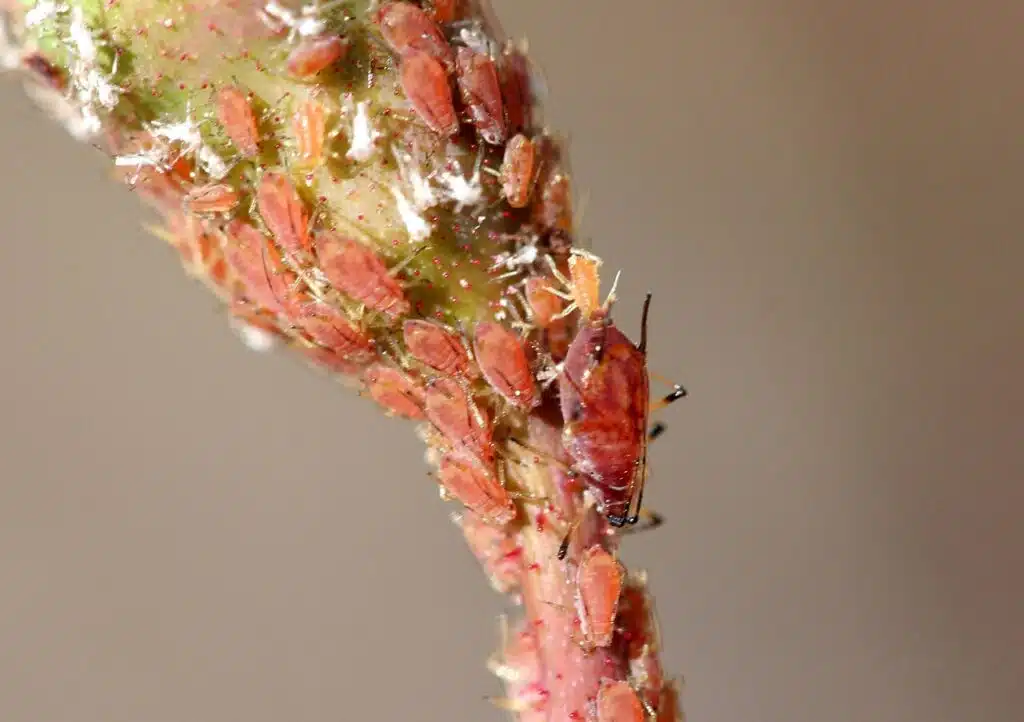
This is the case of the dark red Rose aphids (Macrosiphum rosae). The highest impact of these aphids is on rose plantations, where management techniques are needed.
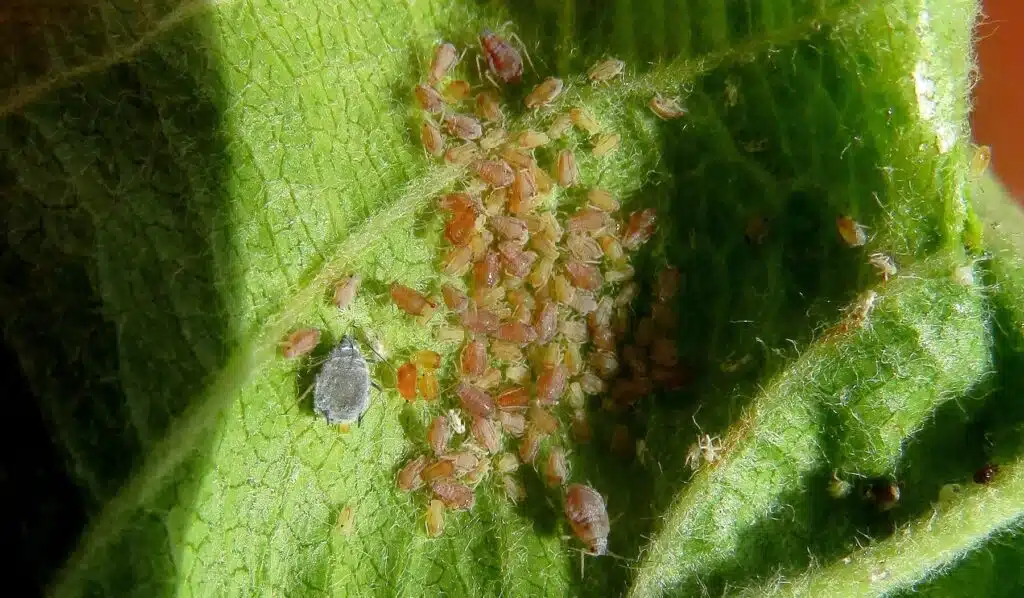
Another very common species of red aphid is the Rosy Apple Aphid (Dysaphis plantaginea). This is a red species that impact apple tree leaves and fruits in the spring. Damages can be vast on plantations where this species can lead to stunted growth, low apple production, and eventually, tree death if left unmanaged for years.
2. Spider Mites
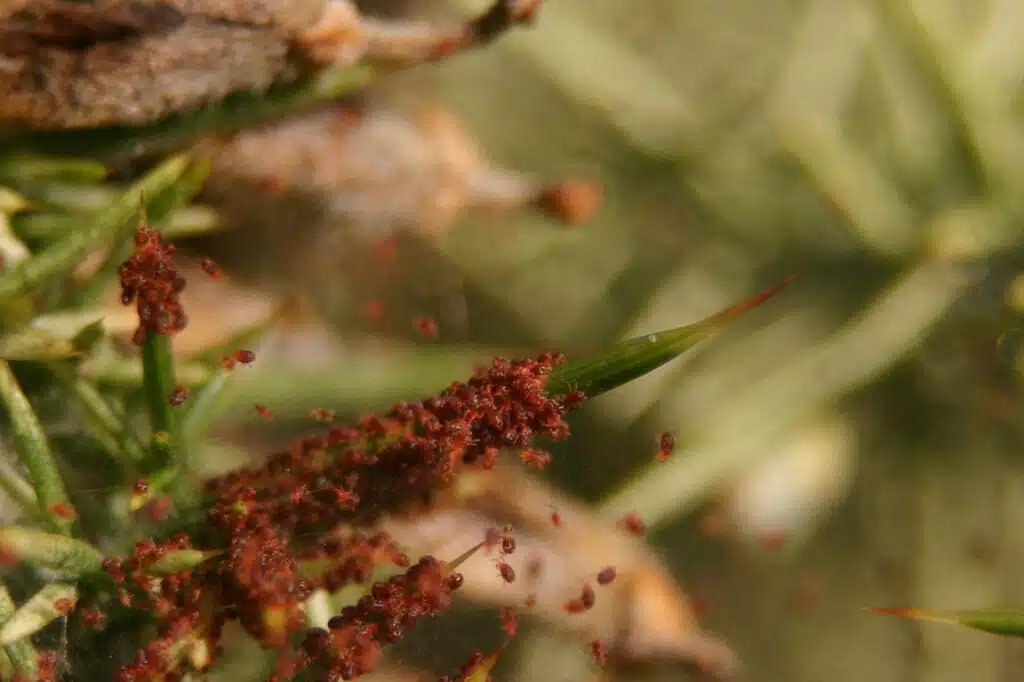
Flowers are some of the most impacted types of plants when it comes to spider mites. Red spider mites eat azaleas in the garden.
These types of bugs are often confused with small spiders.
However, they are much more damaging to azaleas and some types of apple trees.
One of the main problems of these spider mites comes with their reduced size. You may not be able to spot all of them which means you cannot easily remove them.
Buying lacewings is one of the natural control methods to consider against these bugs. Lacewings are predatory and can eliminate red spider mites in the garden.
3. Red Ants
Multiple species of ants can be spotted around the garden. Some of them are red but their coloring alone doesn’t help you understand eliminating them.
Red ants are present in plants due to the high number of aphids in the areas. Aphids leave a residue known as honeydew.
This is sweet residue ants love and it attracts them to plants.
As a result, the best way to get rid of red ants on plants is to eliminate aphids on plants as they attract multiple species of ants.
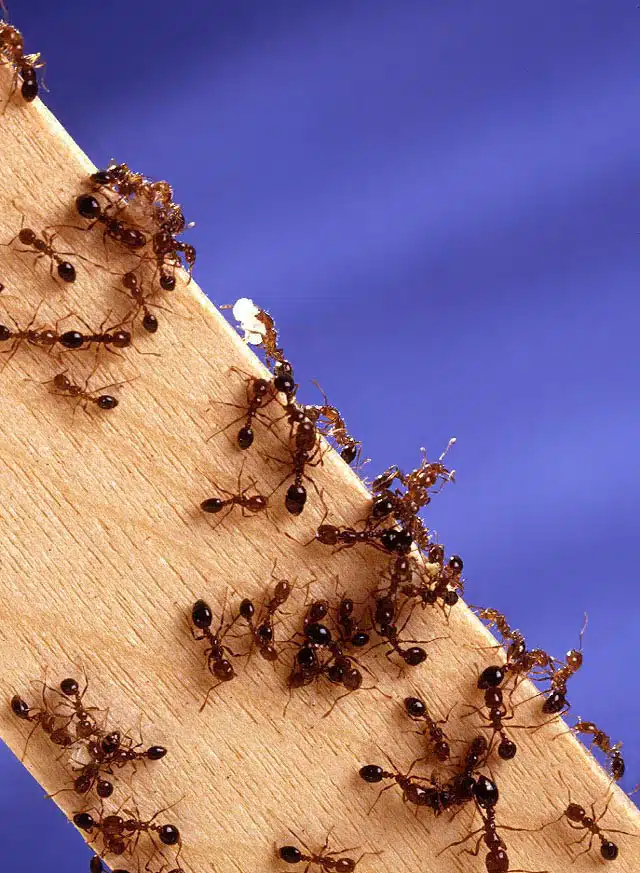
The red imported fire ant (Solenopsis invicta) is an example. Red imported fire ants are some of the most widespread omnivores. These types of ants eat sweet honeydew aphids that cover plants.
Large colonies of these ants are also specific for the specific colonies that also feed on insects. These ants can also eat dead insects.
Some types of Red imported fire ants can also eat dead animals.
These ants are some of the most problematic on citrus and potato crops where they’re seen as pests.
They can even chew through electric cables on tractors and other agricultural machinery.
Some also see these ants as beneficial. They can eat all types of pests and insects as well.
Baits are commonly used to kill Red imported fire ants on crops and in the garden.
4. Scale Insects
Scale insects resemble aphids but they can have both a soft body and a hard shell. Small red scale insects are found on plants as they use them for food.
These small pests might be difficult to spot at first as they only grow to a maximum size of ½ inches. Most are even smaller.
Insecticidal soap is used against scale insects. Using a gardening hose to wash down the plants can also help remove scale insects when only present in small numbers.
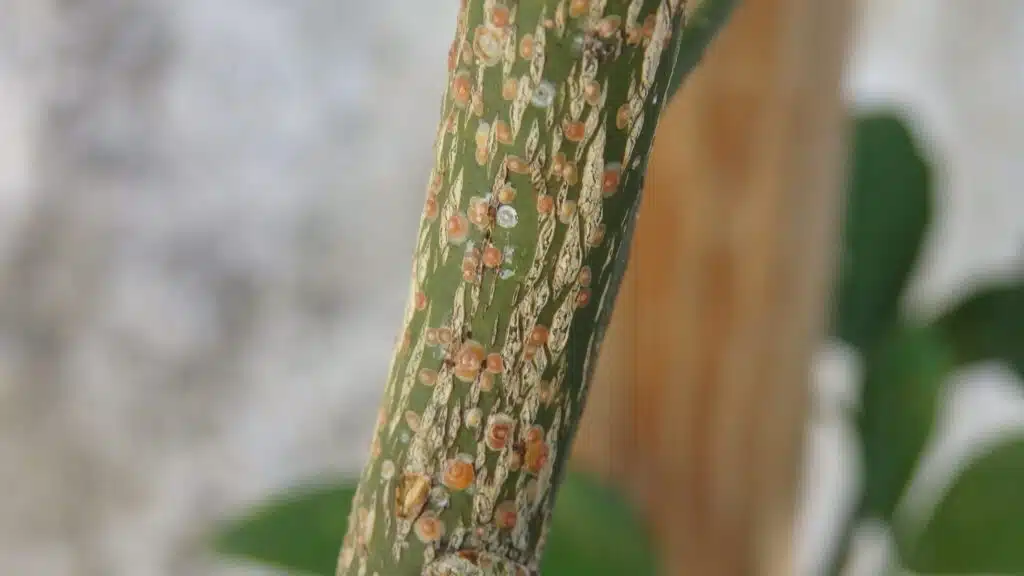
Red Scales (Aonidiella aurantii) show higher resistance to insecticides. This is why natural predators such as ladybeetles are encouraged against the species.
5. Red Beetles
Red beetles are sometimes seen as friendly bugs as they’re often associated with lady beetles. Their presence on plants might not be seen as detrimental but it may be a warning sign other bugs are eating the plants as many red beetles are predatory.
- Scarlet Lily Beetle (Lilioceris lilii)
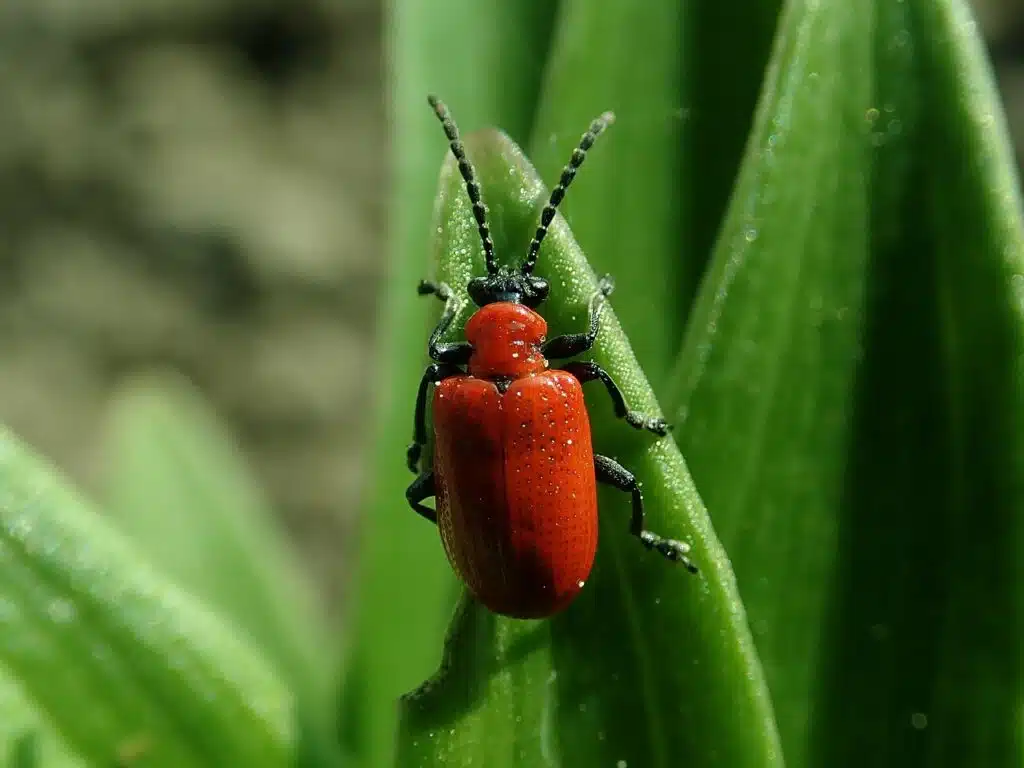
These are some of the most problematic beetles as their presence in the garden is a warning sign to lilies. They feed on the leaves and flowers of lilies and need to be manually removed from plants.
- Red Milkweed Beetle (Tetraopes tetrophthalmus)
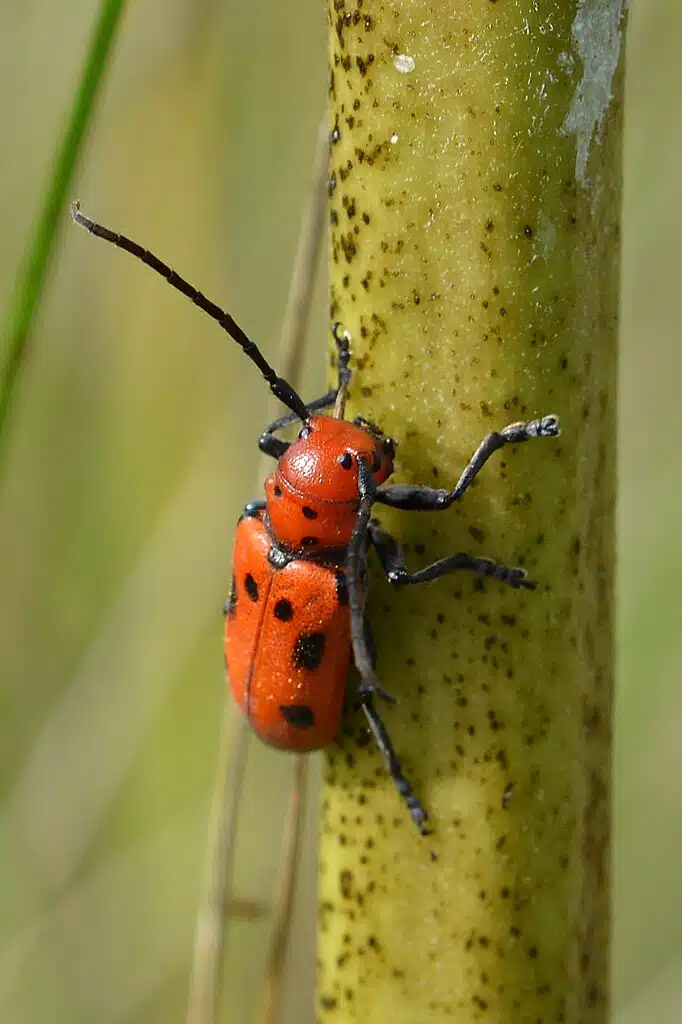
This species of beetle is known for its high impact on milkweeds. These red bugs look slightly different from others as they show tiny black spots on the elytra, similar to lady beetles.
Unlike lady beetles, Red Milkweed Beetles have elongated bodies. The highest numbers of these beetles are seen in late summer.
6. Chiggers
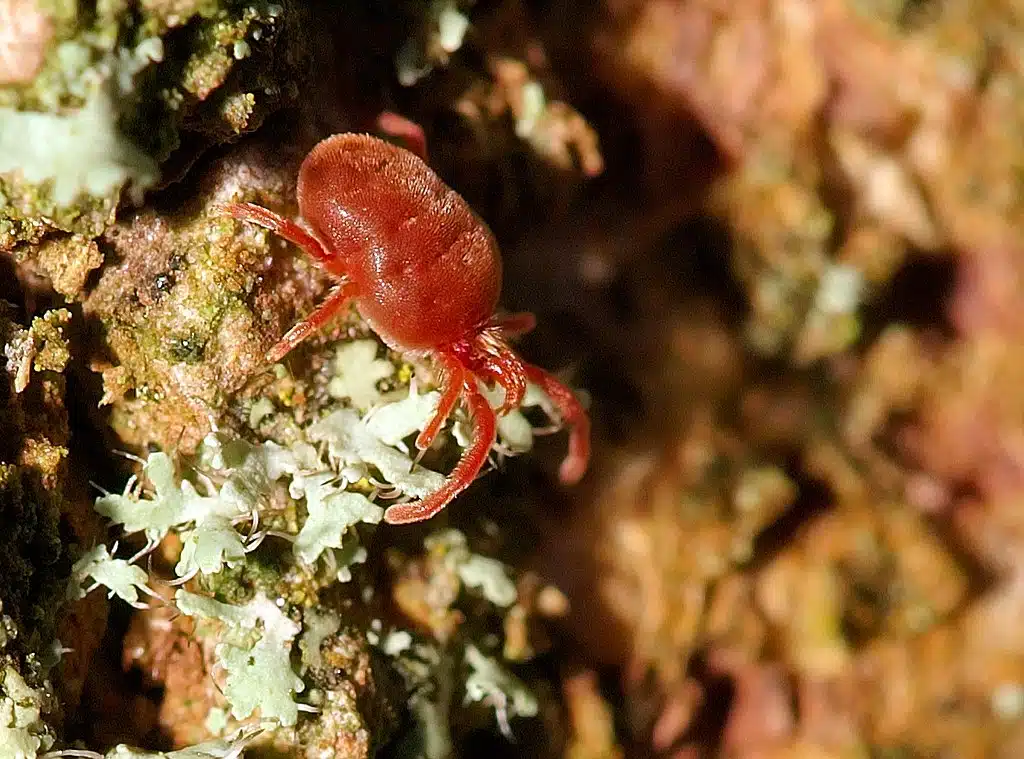
Red chiggers are among the most common species that can bite humans. These red bugs are known to have painful bites.
Commonly picked up from vegetation outdoors, chiggers can also live in parks and gardens.
Adult chiggers feed on arthropods. They spend most of their lives in the ground but they can be picked up and brought indoors whenever you dig in your garden.
7. Clover Mites
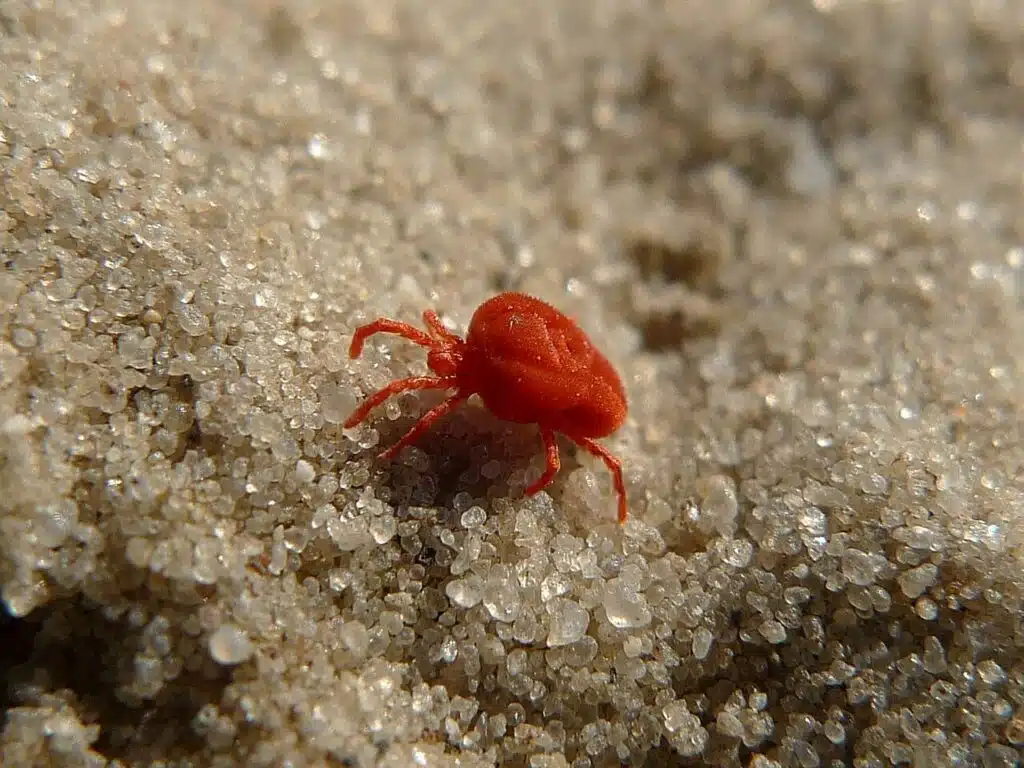
Clover mites are small dark red bugs that feed on vegetation. These bugs only grow up to a size of 0.85mm.
Most clover mites around the house are found on the lawn. The most fertilized lawns are also some of the most attractive to these mites.
One of the recommended methods of preventing clover mites around the garden and the house is to use minimum fertilization.
8. Ticks
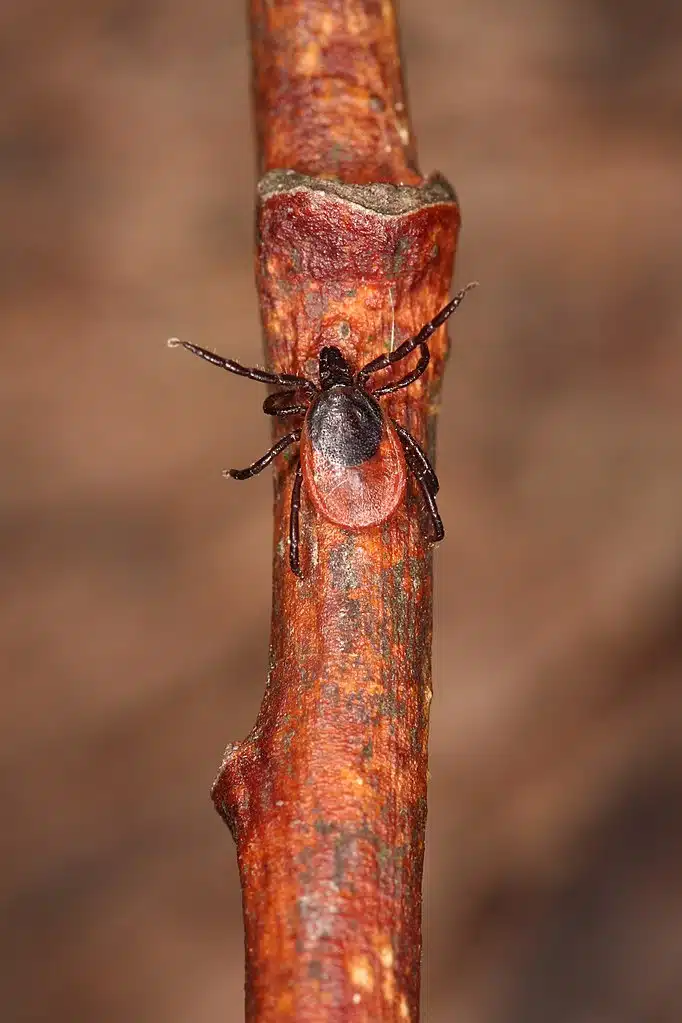
Ticks are some of the smallest parasites in the world. They love humid and warm climates.
Unlike other types of red bugs on plants, ticks require a blood meal.
This is why these bugs are more likely to be spotted around flowers visited by pets, mammals, and birds.
While ticks can live in almost any habitat, they prefer the edges of woodlands or dense vegetation areas. It’s here they find plenty of hosts for a blood meal, including reptiles.
9. Seed Bugs
Seed bugs are some of the most common red bugs that feed on plant sap. There are numerous types of red bugs that feed on plants and all can be safely removed by hand or by washing the plants with a gardening hose.
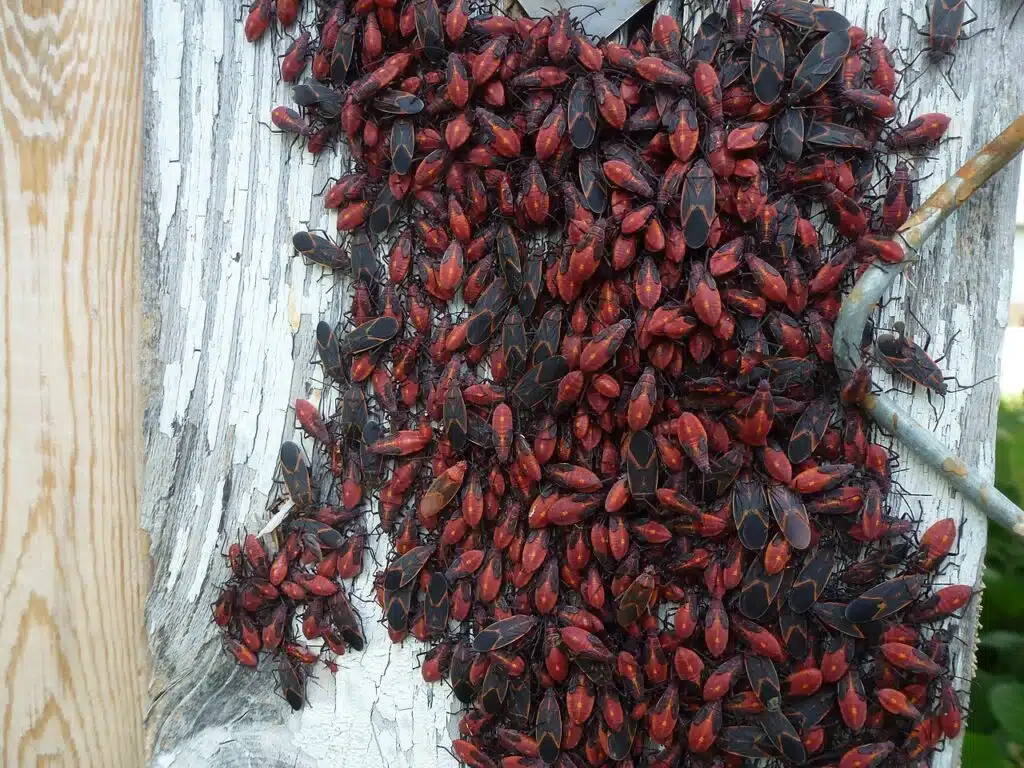
The nymphs of Boxelder bugs (Boisea trivittata) are bright red as opposed to the red and black coloring of the adults.
Nymphs feed on plant sap and the various plant seeds they find around the garden.
Adult Boxelder bugs might even be found indoors when seeking a warm place to hide in.
Plant damage caused by these nymphs is minimal but insecticide but be used to keep them away.
10. Assassin Bugs
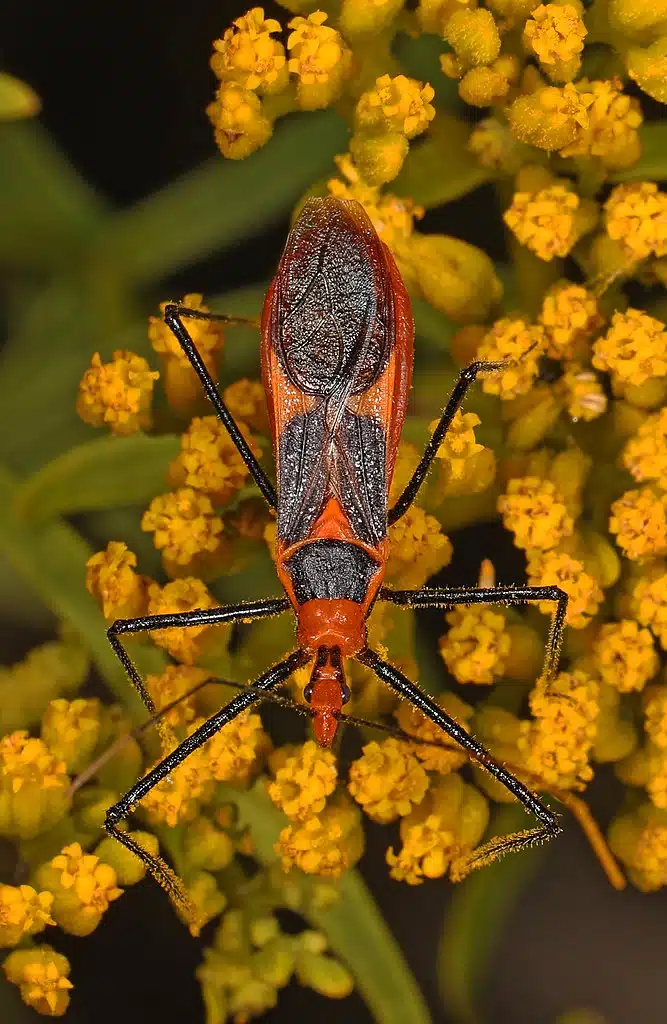
The red coloring is also spotted on assassin bugs.
Nymphs are among the most common types of red assassin bugs. They eat dead insects or the remains of dead insects.
Some red assassin bugs are predators while others suck blood.
Red Milkweed Assassin Bugs (Zelus longipes) are seen as beneficial. They control pest populations in crops and gardens.
This type of assassin bug feeds on the caterpillar of Fall Armyworm moths.
11. Stink Bugs
There’s a long list of red stink bugs your garden, plantation, or plant can be invaded by.
One of the common species of Stink Bugs with a memorable dark red color is The Redbanded Stink Bug (Piezodorus guildinii).
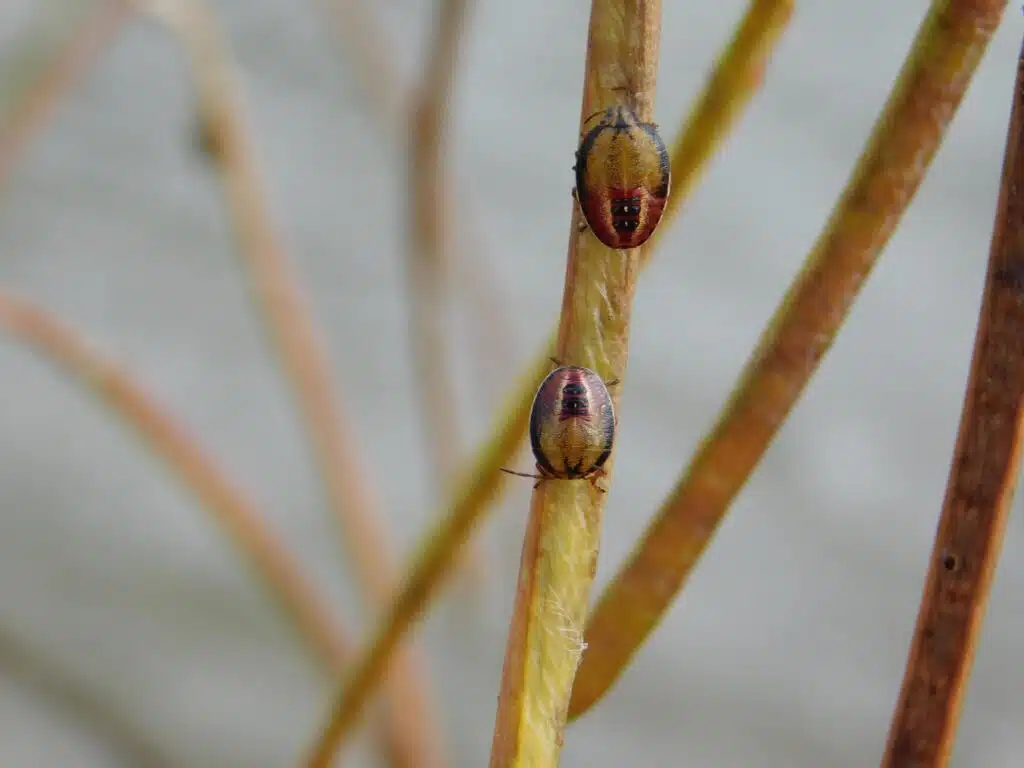
These bugs impact peas and other plants in the pea family.
One of the main troubles with the Redbanded Stink Bug is its resistance to insecticides.
It develops a strong resistance against these chemicals over time which means your pea crops are left exposed even when using the most potent liquid solutions against the bugs.
Physical removal remains the main method of dealing with these types of red stink bugs on peas.
You need to always look for these bugs and their eggs as they can rapidly multiply on pear crops.
A common method of actually removing them and their eggs is to use a sweep net. This type of net is used to clear pea plants of these bugs daily.
Furthermore, those growing peas and pea plants commercially even pay workers to use a sweep net twice per day.
These nets are used to clear plants both in the morning and in the evening as these bugs still require a lot of attention.
Another prevention method against red stink bugs on crops or those feeding on legumes is to only plant and grow plants and vegetables that mature rapidly.
Peas that are harvested quicker than regular peas are ideal here. These bugs don’t get the chance to spread out before harvesting time comes.
12. Ladybugs
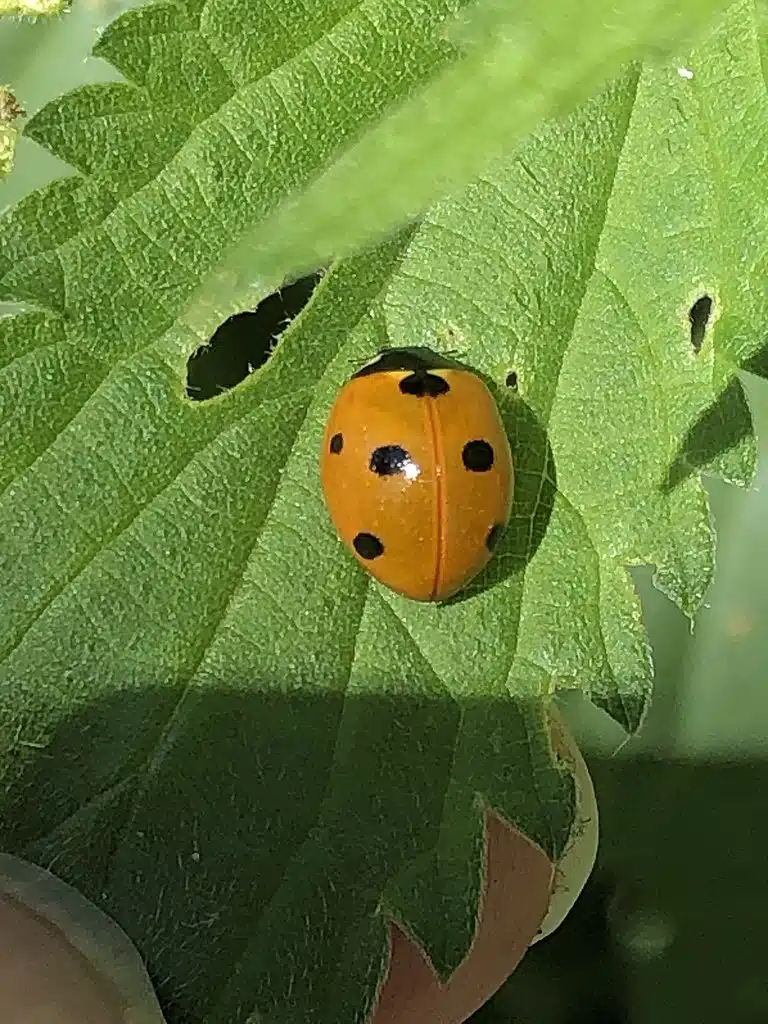
Ladybugs are a frequent sight in gardens. These small beetles come in different colors. Red ladybugs are generally seen as a biological control agent and are warmly received on crops.
Meadows, crops, gardens, and other fields are the common habitat of the Seven-spotted Ladybug (Coccinella septempunctata).
This is a predatory species that live in the same habitats as aphids.
North America and Europe are continents where this ladybug is actively used as a predator that eliminates aphids on crops.
Are Red Bugs Harmful?
Red bugs on plants may or may not be harmful. Species that feed on plant sap such as aphids are harmful.
They can lead to stunted plant growth but they can also leave a honeydew residue that attracts other species such as ants.
Other types of bugs such as ladybeetles aren’t harmful to plants. Removing them isn’t necessary as they can even act as biological control agents by eating soft-bodied bugs.
Ways to get rid of red bugs on plants
Eliminating bugs on plants is an ongoing process. This is a process that involves both prevention and physical measures in the case of bug invasions that are immediate.
Here’s how to get rid of red bugs on plants for good.
1. Pesticide control
Pesticides are strong chemicals that kill bugs in plants. While it’s always best to refrain from spraying pesticides, this is sometimes needed, as in the case of crops.
Most crops cannot be simply sprayed with pesticide by an unauthorized person. A professional needs to come and spray crops as there are many variable elements such as possible contamination of nearby non-pesticide grown crops when the chemicals are carried by the wing.
Pesticides can be used both on affected plants and on plants that pose the risk of being affected by red bugs.
2. Manual removal
Manual removal remains the hardest but the least-impactful solution to remove red bugs from plants. Some plantations pay workers to manually remove all bugs from the plants.
Gardens or a small number of plants around the house can be managed by hand, by a single person. You can wear gloves to protect your hands and start manually removing each visible bug on plants.
A plastic bag can be used for storage. This method is ideal for larger bugs such as aphids but also shows limitations.
One of the limitations of manual removal is the fact you cannot see and remove the eggs of these bugs which means they can be back in days or weeks.
3. Spray neem oil
Neem oil sprays are a less impactful solution against red bugs if you don’t want to use pesticides.
Other types of natural essential oils can also be mixed with water and sprayed directly on plants to kill at least some of the bugs on them.
Recommended essential oils apart from neem oil include coriander oil which its a pungent aroma. Peppermint and rosemary essential oils are just as good as coriander oil as they also drive many bugs away or they may even kill them on the spot.
Frequent spraying is the best preventive measure as well. You can spray your plants with essential oils before the bugs come around.
4. Consider vinegar or alcohol sprays
Alcohol acts the same way as essential oils but at a higher scale. It deters bugs, insects, and even pets in the garden.
Unlike most essential oils, alcohol sprays can be detrimental to plants when overused. This is why it’s best to set a spraying routine so that you don’t damage the plant roots with too much alcohol.
Vinegar sprays are less potent version than alcohol but still stronger than some essential oils. You can find vinegar is a more natural solution against bugs than alcohol.
You may consider frequent vinegar plant spraying to deter bugs if you see rare alcohol sprays not keeping all bugs away.
5. Buy and release predatory bugs
Ladybugs, thrips, and lacewings are some of the known predatory species with a considerable impact on bugs feeding on plants.
These are predatory species known to eat plenty of bugs and even eliminate them in large areas such as on crops.
You can buy these bugs in bulk or you can encourage them in an area by not using pesticides which also drive predators away, not just red pest bugs.
Ladybugs are known to eat small and large aphids, soft bugs they can easily chew. They can also eat all of their eggs on plants ensuring these bugs don’t resurface shortly.
Sprinkle hot pepper powder around the garden
Potted plants or a limited number of plants can also benefit from chili powder. This sprinkled powder acts as a potent deterrent to many types of red bugs.
Some of the most annoying types of red bugs can even fly away immediately after you sprinkle chili powder on a plant or at the base of a plant. This method has its limitations as well.
Hot pepper powder can easily be carried away from plants with strong winds making room for red bugs to return.
Wash plants down with the garden hose
Gardens with irrigation can also benefit from physically removing the bugs with water.
A gardening hose and good water pressure can be a solution to immediately wash plants and remove bugs and their eggs.
This solution is almost ideal for plants you already water daily. Since you water these plants, you can wash them with a gardening hose for bugs and eggs.
However, the solution itself is not sufficient against resilient species or bug invasion. This is why it may need to be coupled with other methods to keep red bugs from plants.
You can spray your plants with essential oil to keep bugs away after washing the visible bugs with a gardening hose. This acts as a preventive measure until the following day when you return to wash the plants or legumes again.
Violets are among the flowers that need daily watering and a species you can use this method on. Vegetables such as tomatoes and cucumbers also need daily watering.
You can wash these plants with the gardening hose and then spray essential oils on them to fully protect the species from most bugs at least for 24 hours.
Prevention
Eliminating red bugs might not be complicated but it may be already too late for your plants. Most plants have at least some types of bugs that are minor or major pests.
Red bugs are best prevented as removing them shows limitations and many run away.
Consider isolating new plants
One of the ideal methods of keeping red bugs away is by limiting the damage they create to new plants.
You risk infesting new plants whenever you introduce them to areas where plants are already invaded by red bugs.
As a result, it’s important to keep new plants away and to take preventive measures on these plants before merging them with old plants which still have red bugs on them.
This can be the case with tomatoes and roses. New rose plants don’t need to be introduced to a rose plantation that still suffers from red bug invasion.
You can grow these new plants in a separate area and ideally consider preventive measures such as spraying neem oil on the.
Wipe the plant down where possible
Some people prefer to wipe down flowers, legumes, and other plants daily. This is the most time-consuming prevention method but also the most thorough.
It’s a time when you get the chance to spot even the smallest health issues of your plants. Wiping your plants daily also means you get to eliminate all red bugs as soon as they appear.
Use fruit tree covers
One of the most expensive but highly effective prevention methods is to use covers against red bugs.
Inspired by plantations and crop farming, this method is suitable during the summer and even around the year.
Some predators don’t appear in the spring, the time many types of red bugs such as aphids make their way to plants.
If you have one, multiple, or even a plantation of apple trees you might consider preventive measures such as installing fruit tree covers.
These covers eliminate almost all bugs that can infest trees.
One of the key elements of the method is to have them properly installed.
The main limitation of the method is the fact that it only works against larger bugs as mites might still get through some fruit tree covers on the market. Encouraging bugs on plants where possible (beneficial to the ecosystem in the food chain)